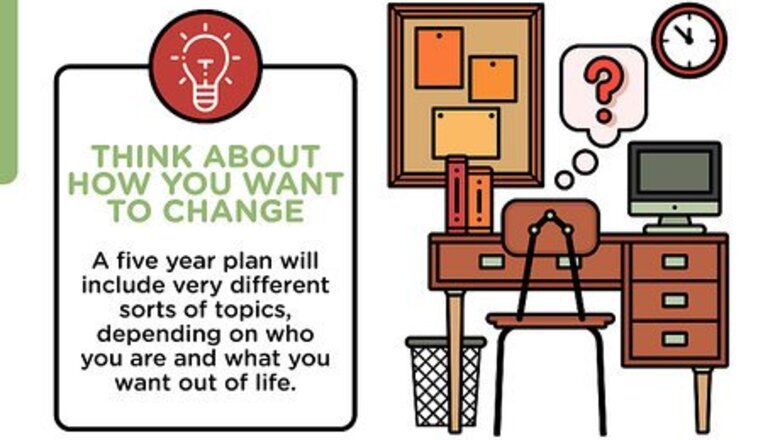
views
Creating a 5-Year Plan

Visualize where you want to be in 5 years. At this stage, you're just brainstorming and dreaming. Imagine where you'd like to be, what you'd like to be doing, even who you hope to be with and what you're going to look like. All of these things are potential goals that you can achieve (or be well on your way to achieving) through a 5-year plan. Think about improvements you might like to see in areas like your health, relationships, career, family, community, religion or spirituality, or hobbies and recreation. For example, if you see yourself as a physically fit person running in a marathon, you might design a health-focused 5-year plan with the goal of getting in shape and starting a regular running training program. If you're working on a career-focused 5-year plan, you might create a fictional résumé for yourself in 5 years. This helps make the goals you set along the path to success more concrete. Just don't submit your fictional résumé for a job opening!
Choose specific areas to focus on. Of all the things you've listed, think about the ones that are most important to you. It's generally better to focus on only one or a few things at a time, so look for goals that are HARD—heartfelt, animated, required, and difficult. These will be the things that you'll be most motivated to achieve. HARD goals are things that you can't imagine life without. If you didn't achieve these things, you would feel as though something was missing in your life. Life and career coach Shannon O'Brien agrees that you're more likely to achieve your goals if you have fewer to focus on, saying, "I think it might be a mistake to set too many goals because it can become overwhelming."
Reflect on your values and find your "why." Your "why" is the ultimate reason you want to achieve something in your life. To find it, start with a 5-year goal and ask yourself why you want that thing. Then, ask "why" about your answer. Keep going in the same way until you've arrived at an answer that gets down to a core value for you. This is your "why." For example, if you want to become more physically fit, your first answer might be so that you feel better about your body. But if you keep digging, you might find that what you're really concerned about is being around and being healthy for your family. Your family is your core value. O'Brien cautions that "if you're setting a goal because it's actually what your spouse or friend or parent thinks is going to be impressive, if you're doing it for someone else, that's a mistake." Instead, she advises that "you should only set goals that are really for yourself and they're really coming from a good place."
Create annual goals that will get you to your ultimate 5-year goals. Annual goals are typically going to be pretty big milestones that you can see are putting you one step closer to achieving your ultimate 5-year goal. Make them challenging—things that you'll have to stretch and work hard to achieve. For example, if you have a 5-year goal of running in a marathon, running a 5K wouldn't be a suitable goal for Year 1. There are many Couch-to-5K programs that can be completed in 30 days, so that goal wouldn't be challenging enough.
Break down your annual goals into monthly goals. Long-term goals aren't really achievable until you break them down into smaller goals that you can measure and track. These goals are SMART—specific, measurable, achievable, realistic, and time-based (or trackable). The steps that you take to achieve these goals are typically going to be more concrete than the larger milestones for long-term goals. For example, if your 5-year goal is to run a marathon, your short-term goals would likely involve running shorter distances, or running a shorter distance at or under a specific time. Choose goals that are based on your performance, not on the outcome. These are more specific and measurable. For example, rather than setting a goal of being fluent in a language, you might set a goal to learn 10 new words every day.
Research how to reach your monthly goals. You've got some difficult, ambitious goals to really change your life—good for you! Now all you have to do is figure out how to get there. Dig into information about those goals so you can plan out exactly what you'll need and when you'll need to do it to stay on track with your plan. For example, if you have a goal related to physical fitness, you might need to buy a gym membership or hire a personal trainer. Some goals might require you to learn things. For example, if one of your goals is to teach English in Venezuela, you might need to learn Spanish first.
Write out your plan and keep it somewhere easily accessible. It's great to have a visual reminder of your goals and how close you're getting to achieving them. Plus, who can deny the pleasurable sensation of crossing something off the list when you're finished with it, then looking to see just how far you've come. You might hang a copy of your 5-year plan in your bathroom so you can reflect on it while you're getting ready in the morning, or near your desk so you'll see it while you're working. Don't be shy about your 5-year plan—share it with friends and colleagues who can cheer you on, help motivate you to achieve your goals, and hold you accountable.
Revisit your plan and revise it as necessary. Your 5-year plan isn't etched in stone—and if it was, it would likely do you more harm than good. The truth is, a lot can change in 5 years, and the things you thought were super-important when you originally wrote your 5-year plan might not be relevant even 2 years out. For example, what if your 5-year plan was to run a marathon, but you're running half-marathons with ease after 1 year of training? It's not going to take you 5 years to get ready for the marathon, so you might revise it to a 2- or 3-year goal. Sometimes you'll also want to revise your plan due to a change in circumstances beyond your control. For example, you'd likely scrap your 5-year plan to pay off your student loans if the federal government announced all student loans were being forgiven.
What is a 5-year plan?
A 5-year plan organizes your personal or professional life. When you sit down to create a 5-year plan, you're thinking about where you want to be and what you want to have accomplished 5 years from now. The plan itself illuminates a path toward achieving those ultimate goals, complete with smaller steps and milestones for you to achieve along the way. The most important thing to remember about a 5-year plan is that it's never set in stone. A lot can happen in 5 years, so it could be that everything in your plan will change. The point of the plan is to show a way that you can achieve your goal, even if it ends up not being the way you ultimately get there. Any 5-year plan tends to center around your goals, but goals and plans are two very different things. Your goals are what you want to achieve while your plan is like a roadmap that tells you how you're going to get there.
Benefits of a 5-Year Plan
Motivation Making a plan to accomplish your goals will help you feel better about your ability to get where you want to be. When you don't have the steps laid out, it's often hard to get going because you're unsure what to do first or how that will help you reach your ultimate goal. Your plan's flexibility also helps motivate you because you aren't as worried about being derailed if you hit a snag. Because you have the big picture in mind, you know you can work through any challenges that come your way.
Clarity Because you've taken the time to plan out how you're going to reach your goals, you know what each step is going to be and what it's going to look like. It's easy to see yourself achieving what you set out to do because you've drawn yourself a clear path to get there. If your plan includes a goal that other people are involved in, the plan also gives those people clarity on what they need to do to achieve the goal collectively. You don't have to wonder if the next steps you're taking are leading in the right direction because you've already plotted the whole thing out. A clear path also enables you to see how to quickly regroup and get headed toward reaching your goal again if you become sidetracked.
Focus It can be easy to lose sight of the fact that everything you do, every choice you make, could take you further along the path of achieving your goals or could set you back. With a 5-year plan in hand, you have a regular reminder of where you want to be and how you want to get there so you can stay focused on the right path and not get distracted or derailed. The plan also allows you to see the whole path clearly so you can understand how each small step that you make is gradually getting you closer to achieving your goal.
Control Because you're planning in advance, you can anticipate stumbling blocks and find ways to work around them ahead of time so they don't have the same negative impact they might've had if you didn't have a plan. You also have more control because you are creating the life you want on your own terms rather than waiting for things to happen to you. For example, if you have a 5-year plan to become partner of your firm, you might take on projects that set you apart from your colleagues or actively pursue promotions. This gives you more control than if you just waited for the higher-ups to notice you.
Organization A 5-year plan gives you the opportunity to figure out what tools, knowledge, and resources you'll need to achieve a certain goal and have those things available when you need them. You won't be taken by surprise or get to a certain stage only to realize that you need things you don't have. When you're plotting out your 5-year plan, you'll naturally think about stumbling blocks that might arise. Then, you can figure out what you'll do to get around them if they do come up. With a 5-year plan, you'll feel like you're on top of things because you have all of the details mapped out. Taking care of the details like this allows you to see the big picture and celebrate all the small accomplishments that eventually lead to major success.



















Comments
0 comment